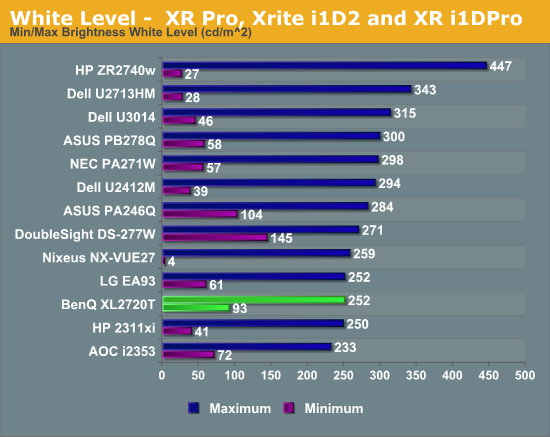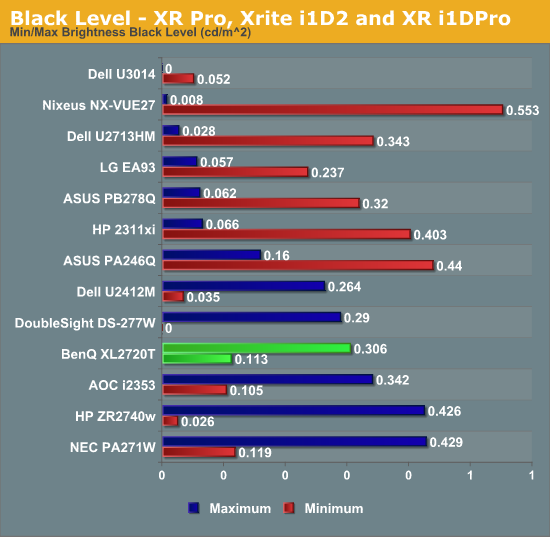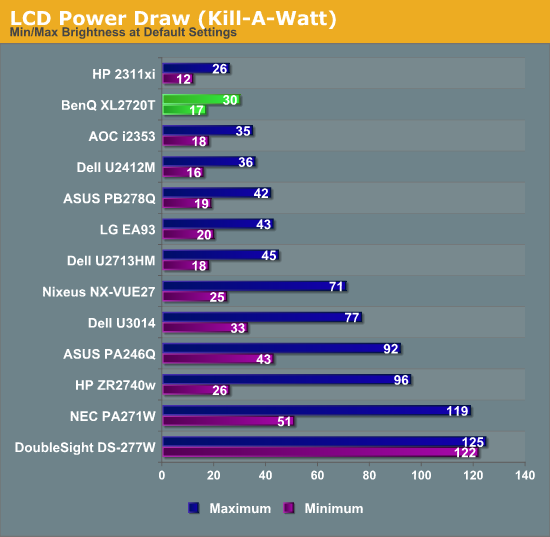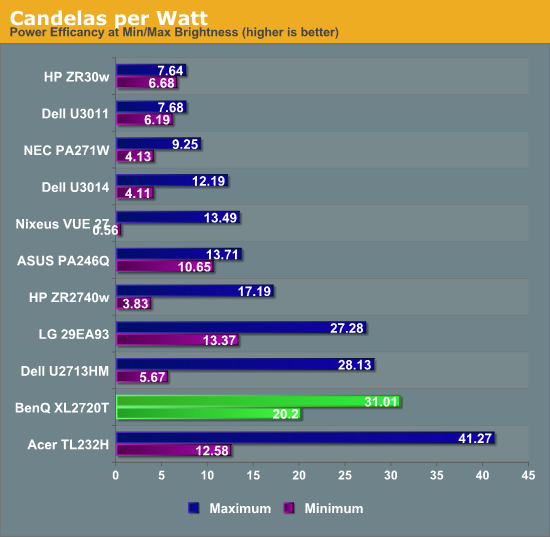BenQ XL2720T Gaming Monitor Reviewed
by Chris Heinonen on June 17, 2013 4:35 PM ESTBenQ says that the maximum light output of the XL2720T is 300 nits, but the most I could record is 252 nits while not totally crushing whites. It might be possible to set the contrast to 100 and record a higher number, but with that setting the top white shades, from around 230 until 255, all blend into a single shade. No one would ever use a display this way, so it’s a bit impractical for me to measure them this way. The lowest white level I could get was 93 nits, which helps to explain the contrast ratio issue on the sRGB test. If we are targeting 80 nits, and the lowest level the display can natively do is 93 nits, then the video card LUT has to be lowered to bring that brightness down. Anytime you lower the peak of the LUT, you then start losing contrast range, which is why we try to get the monitor set as close as possible before calibration, or use DDC to have it automatically do it correctly.

The black level was fine on the XL2720T, though not exceptional as TN isn’t known for being great at blocking out light. It isn’t a bad number, but black level is really all about contrast ratio and on its own doesn’t mean much unless we also know the white value.

The contrast ratio on the BenQ comes out at right around 820:1 at maximum or minimum light level. The lower number we saw on the sRGB calibration was due to targeting a light output level below what the monitor can do natively. If you aren’t trying to go below the 95 nits light level that I saw on the white testing, you will get a contrast ratio right around 820:1 from the XL2720T.

The BenQ XL2720T also does well on power usage, consuming very little at maximum or minimum backlight levels. Other than the Acer touchscreen model, the BenQ is the most efficient monitor for which I have calculated the Candelas per Watt number, which takes into account screen size, power use, and light output to normalize the data. I have a feeling the BenQ benefits by having a lower resolution 27” panel than most of the 27” monitors I’ve tested, but with the small number of data points I have so far that is all conjecture at the moment. Whatever the cause of it, the power use of the BenQ is very low.












79 Comments
View All Comments
metril - Monday, June 17, 2013 - link
Now that others have pointed out, I see the 1080p tag. I agree that a table would have been beneficial. I guess, I'm so used to see tables like in the other reviews that I've come to expect one in any review. It provides a quick overview before I go and read the review. Nonetheless, thanks for the review. :)brucek2 - Monday, June 17, 2013 - link
The list of tags right under the article's title includes "1080p", and then there's the discussion on the next to last page how all current 120hz monitors are 1080.Of course the table is a good idea. I feel like there usually is one? Maybe something got lost in the editorial pipeline?
thwaak - Monday, June 17, 2013 - link
I agree, this was a major oversight. I had to skim the article till the second last page to determine that it was 1080p, and even then it's really not even directly stated.Rob94hawk - Monday, June 17, 2013 - link
Yeah had to read it a few times to figure out what the resolutions was.r3loaded - Monday, June 17, 2013 - link
Are there any 120Hz IPS monitors? I'm sure many people would want one.jackstar7 - Monday, June 17, 2013 - link
Overlord is one of the places you can get the closest thing to 120Hz IPS (at 1440p). Takes some gfx horsepower, but is worth it.Rob94hawk - Monday, June 17, 2013 - link
No offense but 2560x1440, 2560x1600 gaming is where it's at. Reviewing a 1080p monitor is like reviewing socket 775 all over again.birru - Monday, June 17, 2013 - link
That's a complete exaggeration. High resolution gaming is awesome, and there's real value there, but 1080p is absolutely relevant. Especially when you factor in trying to maintain 120fps or 144fps to keep up with these high refresh LCDs while avoiding tearing. Even with my GTX 780 I've found that with some recent titles I have to scale back the eye candy a touch to keep the experience at a solid 60fps. And that's at 1080p. So with a top of the line single GPU you'd certainly have to reduce visual fidelity a bit more at higher resolutions. And of course it gets worse with triple screens if you want to go that route. 3x1080p is feasible with one GPU. 3x1440p and you're looking at SLI or Crossfire.Resolution costs money; how sharp do you want to go?
sxr7171 - Monday, June 17, 2013 - link
Same issue here. 780GTX and I need to turn settings down in Crysis 3. This is at 1080p. Can't imagine how that would work out at 1600p. I guess SLI is a must with those resolutions along with all the problems.brucek2 - Monday, June 17, 2013 - link
Per Steam, 1080p and under is something like 98%+ of all gamers (and this is billed as a "gaming monitor" review.)Sure I'd expect that the percent of newly purchased monitors may be somewhat higher, but I bet it's still well south of 10%.